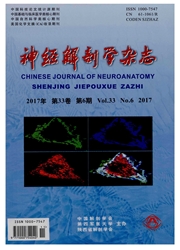

 中文摘要:
中文摘要:
目的:长时程易化(long-term facilitation,LTF)是反映呼吸可塑性的重要电生理指标,与睡眠呼吸紊乱疾病密切相关。3~5个低氧周期的急性间断性缺氧可以诱导膈神经LTF,而持续一周以上的慢性间断性缺氧(chronic intermittent hypoxia,CIH)可以诱导更大的增强的LTF(enhanced LTF)。以往制备CIH大鼠LTF模型多用氧(10%)+氮(90%)混合气(5 min)、常氧(5 min)交替通气,每天12 h,连续7 d以上,实验需要大量混合气,费用较高。我们模拟高原缺氧制备了低压氧舱大鼠CIH模型,表达增强的膈神经LTF。方法:成年SD大鼠置于密闭容器内进行5 min低压缺氧、5 min常氧交替通气,每天12 h,持续7 d。通过空气抽提进行低压缺氧,使舱内气压逐渐下降到210~220 mmHg,相当于海拔约9000 m。第8 d,动物进行急性间断性缺氧,诱导膈神经LTF表达。对照组大鼠只进行急性间断性缺氧,统计学分析两组动物膈神经LTF的表达变化。结果:低压氧舱CIH大鼠较正常对照组对缺氧反应更加敏感,表现为缺氧期膈神经放电的频率和幅度快速增加。在急性间断性缺氧结束后30 min和60 min,CIH组大鼠膈神经放电幅度较基础水平分别增加了(116.3±6.5)%和(106.1±19.2)%,而对照组分别增加(60.4±7.8)%和(48.2±11.0)%,两组之间有显著性差别(P(0.01),表明CIH诱导了比对照组更加强大的LTF,形成增强的LTF。结论:我们建立了低压氧舱CIH大鼠膈神经LTF模型,为进一步研究LTF的发生机理、揭示与睡眠呼吸紊乱疾病的相关性提供了实验平台。
 英文摘要:
英文摘要:
Objective: Long-term facilitation(LTF) is an important electrophysiological characteristic indicative of respiratory neuroplasticity,and is tightly related to sleep disorders.Phrenic LTF can be induced by acute intermittent hypoxia(AIH,3-5 episodic hypoxia),whereas chronic intermittent hypoxia(CIH) lasting for over one week leads to a large enhanced phrenic LTF.CIH rat models is usually prepared with alternately 5 min of 10% O2 + 90% N2,and 5 min of normoxia for 12 h/d for at least 7 d,a process that needs large amount of mixed gases,and is expensive.We aimed to establish an enhanced phrenic LTF model in intact rats in precondition with hypobaric chronic episodic hypoxia.Methods: Adult Sprague-Dawley rats were housed in a chamber and maintained with alternately 5 min of hypobaric hypoxia and 5 min of normoxia for 12 h/d for 7 consecutive days.Hypobaric hypoxia was achieved by air evacuation to gradually reach a pressure of 210-220 mmHg,corresponding to an altitude of around 9000 m.On the eighth day,both CIH and control animals were treated with AIH,to induce phrenic LTF expression.The control animals received AIH challenge only.Alterations of phrenic LIF expressions between two groups were then statistically analysed.Results: Phrenic nerve activity was more sensitive in response to hypoxia in CIH rats than that in control,showing rapid increases in frequency and amplitude during hypoxic period.The integrated amplitudes at 30 min and 60 min after episodic hypoxia were(116.3±6.5)% and(106.1±19.2)%,respectively,from baseline in CIH animals,which were significantly different from those(60.4±7.8)% and(48.2 ±11.0)% in control(P0.01),indicating a much larger LTF induced by CIH,the enhanced phrenic LTF.Conclusion: We establish an enhanced phrenic LTF model induced by chronic intermittent hypobaric hypoxia in intact rats,which will provide a useful platform for understanding the mechanism of LTF expression and its relationship with sleep disorders.
 同期刊论文项目
同期刊论文项目
 同项目期刊论文
同项目期刊论文
 期刊信息
期刊信息
